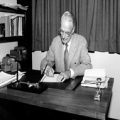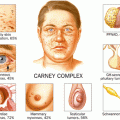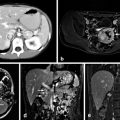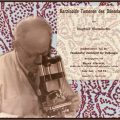J. B. Collip as Dean of Medicine, in his office at the University of Western Ontario, ca 1950s. (Photo used with permission from Western University, Western Archives, History of Medicine Collection, London, Ontario, Canada)
James Bertram (Bert) Collip was born in Belleville, Ontario, Canada, on November 20, 1892. He had a great interest in chemistry, and must have been an exceptional student, as he entered Trinity College of the University of Toronto at the age of 15. He apparently wanted to study medicine, but was too young to enter medical school. He therefore enrolled in the honours biochemistry and physiology degree program that allowed entry into the later medical years. He excelled there, inspired by A. B. Macallum, the first biochemistry professor in Canada. After graduating at the top of his class, Collip chose to pursue a graduate degree rather than medicine, receiving his PhD in 1916 for studies of hydrochloric acid production by the gastric epithelium (Fig. 1).
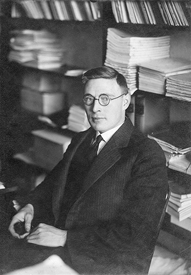

Fig. 1
James Bertram Collip—pioneer of Canadian endocrinology (1892–1965) around the time of his work on the parathyroids. Undated, but probably in the late 1920s, at University of Alberta or not too long after moving to McGill. (Photo used with permission from Western University, Western Archives, History of Medicine Collection, London, Ontario, Canada)
J. B. Collip at the University of Alberta
In 1915, Collip was offered a teaching and research lectureship position in biochemistry in the new medical school at the University of Alberta, in Edmonton. The position there made strong teaching demands on him, but Collip’s research program quickly became very productive. He was promoted to assistant professor in 1917 and to associate professor 2 years later. He was also given the opportunity to visit other laboratories, and cultivate new areas of interest—a great start to a research career that was particularly notable for his ability to quickly move from one area of enquiry to another.
Following the First World War, the Rockefeller Foundation awarded large grants to enhance medical education in Canada. In late 1920, Collip received a Rockefeller Foundation Travelling Fellowship, which was to afford him a lengthy (15-month) sabbatical from teaching while he visited three prominent scientists’ research laboratories to focus on the biochemistry and physiology of his two main interests: respiration and the “glands of internal secretion” (endocrinology). The initial plan for use of the award was to spend 6 months with Professor J. R. R. Macleod at the University of Toronto; 6 months with Professor D. O. van Slyke, at the Rockefeller Institute in New York; and 4 months with Sir Henry Dale at the National Institute for Medical Research in Hampstead. He chose to first visit Macleod’s laboratory at the University of Toronto, to study the effect of acid–base balance on blood sugar. During this time, he met with Dr. Frederick G. Banting and Mr. Charles H. Best who had begun their studies in Macleod’s laboratory, searching for the glucose-active hormone of the pancreas, and offered advice on blood glucose measurements for Banting’s planned dog studies. The possibility of an offer of a faculty position at Toronto caused Collip to shorten his planned time in the USA so that he could return to Toronto for the 1921–1922 academic year. He did spend the summer of 1921 at the Centre for Marine Biology at Woods Hole and at the Rockefeller Institute, where he continued his studies of mollusc respiration and also acquired expertise in a newer method of blood glucose measurement.
Collip returned to Toronto in the fall of 1921, and the events that followed shaped the rest of his research career. He was invited to become involved in the work that Banting and Best were carrying out with pancreatectomized dogs. They had succeeded in preparing a pancreatic extract that lowered the blood sugar in these newly diabetic dogs. Collip helped the team show that the pancreatic extract increased glycogen stores, and showed that the extract lowered blood glucose in normal rabbits, allowing the establishment of a bioassay to calibrate the potency of the pancreatic extracts. Injections of large doses of the extracts were observed to cause fatal convulsions in the animals. It was Collip who shrewdly deduced that the cause of the convulsions was hypoglycaemia, and the animals could be rescued by glucose administration. Collip then set about improving the yield of insulin in the extraction process and did so by increasing the concentration of ethanol in the extraction solution. The highly purified extract was used in a successful clinical test in January 1922. For a short period of time, Collip lost his ability to purify the extract, as he had broken a biochemist’s cardinal rule of keeping an accurate record of his methods, but eventually the technique was recovered. Successful clinical testing of the extracts continued, and a manufacturing agreement with Connaught Laboratories in Toronto and Eli Lilly and Company in Indianapolis allowed a rapid increase in the manufacturing capabilities of insulin, for which there was an immediate huge demand. The research group debated the ethics of whether they should apply for a patent, and finally decided to do so under the names of Collip and Best, with the patent being assigned to the University of Toronto. The royalties from this patent were to provide significant research support to Collip’s laboratory for many years afterward.
During much of his stay in Toronto, Collip was in negotiations with the University of Alberta regarding the nature of his appointment and remuneration there, and he used job offers from other centres as a bargaining chip. The negotiations continued through most of his stay in Toronto, but it was finally agreed that when he returned to the University of Alberta he would have a full professorship, the headship of the soon-to-be-formed Department of Biochemistry, and increased laboratory assistance. The results of the clinical testing of insulin were presented in May of 1922, at the Royal Society of Canada, and Collip returned to Edmonton shortly thereafter.
The discovery of insulin brought the Nobel Prize in Medicine to Banting and Macleod, and immediate fame to all members of the research team. Recognizing the potential clinical importance of glandular extracts, Collip switched his research focus away from respiration and molluscs. The desire to have a more clinical focus to his research probably contributed to his decision to complete a medical degree at the University of Alberta. Because of his PhD in biochemistry and physiology, he was only required to complete the final two clinical years of medicine, obtaining his MD in 1926. Amazingly, he completed these clinical training requirements, while carrying out some of his best research.
Shortly after the success with insulin, and before his work on the parathyroid hormone (PTH), Collip prepared an insulin-like extract from plants, which he named glucokinin. Despite an optimistic paper in the Journal of Biological Chemistry [1], and several follow-up studies, glucokinin failed to live up to his hopes. When toxicity problems became apparent, Collip abandoned this line of research in favour of studies of the parathyroid: the extraction of biologically active PTH, and the characterization of its major physiological effects on calcium metabolism.
Why did Collip choose the parathyroid and calcium as his next line of enquiry? His research career was characterized by major directional shifts, but this was not his first venture into calcium metabolism. Prior to his work on insulin in Toronto, in the course of his earlier studies of respiration, he had published experiments in which he correctly identified hypocalcemia as a cause of tetany [2]. Also, in the early twentieth century, hypoparathyroidism and its resultant tetany was becoming a fairly common and occasionally fatal medical complication of the increasing numbers of thyroidectomies performed for goitre, nodular thyroid disease, and hyperthyroidism. Collip’s work on hospital wards as a part-time medical student undoubtedly kindled his interest in this important problem.
Stay updated, free articles. Join our Telegram channel

Full access? Get Clinical Tree



